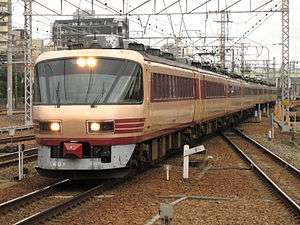485 series
| 485 series | |
|---|---|
|
A "bonnet-style" 485 series train on a Hitachi service, August 1998 | |
| In service | 1964–present |
| Manufacturer | Hitachi, Kawasaki Heavy Industries, Kinki Sharyo, Kisha Seizo, Nippon Sharyo, Tokyu Car Corporation |
| Constructed | 1964–1987 |
| Refurbishment | 1999–2006 |
| Scrapped | 1985 (481 series) |
| Operator(s) |
JNR (1964–1987) JR East (1987–present) JR West (1987–2011) JR Kyushu (1987–2015) |
| Line(s) served | Various |
| Specifications | |
| Maximum speed |
120 km/h (Normal) 130 km/h (Kosei Line) 140 km/h (Tsugaru-Kaikyō Line) |
| Traction system | Resistor control |
| Electric system(s) | 1,500 V DC / 20 kV AC (50 Hz/60 Hz) |
| Current collection method | overhead catenary |
| Bogies | DT32, TR69 |
| Braking system(s) | Dynamic brake, electro-pneumatic brake |
| Safety system(s) | ATS-S, ATS-P, ATC (485-3000 series only), Tōbu ATS (Nikkō set only) |
| Track gauge | 1,067 mm (3 ft 6 in) |
The 485 series (485系) (and its variants) is a Japanese limited express electric multiple unit (EMU) type introduced in 1964 by Japanese National Railways (JNR), and currently used by the East Japan Railway Company (JR East).[1] Until 2011, this series was also used by West Japan Railway Company (JR West) and Kyushu Railway Company (JR Kyushu).
481 series
Introduced in 1964, the 481 series trains ran on the Tsubame service on the Tōkaidō Main Line and Sanyō Main Line from 1 October 1964 to 9 March 1975, as well as on the Hokuriku Main Line. These services were subsequently operated by JR West and JR Kyushu.
Interior
-

Interior of SaShi 481-37 restaurant car, 1985
483 series
This series was first introduced in 1965 and operated on the Tōhoku Main Line (Yamabiko service), and the Jōban Line. Now operated by JR East.
Introduced in 1968, the trains initially ran from Osaka to Aomori on the Hakuchō service. The original design was closely based on the bonnet-style 181 series EMU, with the primary difference being ceilings that were 12.5 cm higher. However, trains produced from 1972 onwards, starting with the 485-200 series, featured a new design with a cab adapted from the 583 series sleeper expresses, which became the standard on nearly all subsequent JNR limited-express EMUs. Hence the 183 series, 381 series, and 781 series trainsets all share the same basic design with the 485 series.
On 27 July 1981, a derailment caused units 485-117 to 484-221 and 481-53 to be damaged and scrapped.
485 series trains were also used on the Raichō and Super Raichō services from 1968 until the service ended in March 2011. These trains sometimes utilized a panoramic cab car (numbered KuRo 481-2000) which was a "Green Car".
The Inaho and Hokuetsu services have used 485 and 485-3000 series trains since 1969.
The Hitachi service used 485 series trainsets from 1969 to 1998, when it was replaced by Super Hitachi and Fresh Hitachi services.
The Tsugaru service has used 485-3000 series trains since 2002, when the service started.
The Nikkō service used a dedicated 6-car 485 series set from March 2006 until 4 June 2011, which was occasionally substituted by a reserve 189 series set nicknamed Ayano. It was replaced by two 6-car 253 series sets from 4 June 2011.
The Noto has used a single 6-car 485 series train since March 2010, replacing the previous 489 series train.
Currently owned by JR East and (formerly) JR West and JR Kyushu, they also operate in the JR Hokkaido area on regular Hakuchō services, and in JR Central and JR Shikoku areas providing extra services.
Variants
- 485 series (original) (from 1968)
- 485-200 series (from 1972)
- 485-300 series (from 1974)
- 485-1000 series (from 1976)
- 485-1500 series (from 1974)
- 485-3000 series (converted from former 485-1000 series trains from 1996 until 2001)
- Joyful Train variants
Limited express
-

485 series train with KuRo 481-0 "Green Car" driving trailer car on Midori service, 1982
-
485 series train on Nikkō service, May 2011
-

485 series train with panoramic cab car (KuRo 481-2000) on Raichō service, December 2006
-

JR West Super Raichō KuMoHa 485-200 coach
-

JR Kyushu 485-200 series, October 2009
-

JR West 485-300 series, October 2009
-

485-1000 series, August 2003
-

JR East 485-1500 series, July 2007
-

A 485-3000 series refurbished train on Inaho service, September 2005
-

A 485-3000 refurbished train on Tsugaru service, November 2007
Joyful Train sets
-
Resort Express Yū, May 2006
-
Utage, September 2006
-
Hana, October 2006
-
New Nanohana, July 2003
-

Yamanami, April 2007
-

Seseragi, May 2009
-

No.Do.Ka, August 2009
-

Irodori, July 2010
-

Resort Yamadori, July 2011
See also
References
Further reading
- Umehara, Jun (22 February 2013). 485系物語 [The 485 series story]. Japan: JTB Can Books. ISBN 978-4533089749.
- 国鉄型車両ラストガイド 05 485系 [JNR Rolling Stock Final Guide 05: 485 series]. Japan: Kotsu Shimbunsha. 3 March 2013. ISBN 978-4-330-36313-4.
External links
| Wikimedia Commons has media related to JNR 485 series. |
| |||||||||||||||||||||||||||||||||||||
| |||||||||||||||||||||||||||||||||||||
| |||||||||||||||||||||||||||||
| |||||||||||||||||||||||||||||


